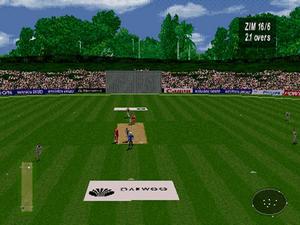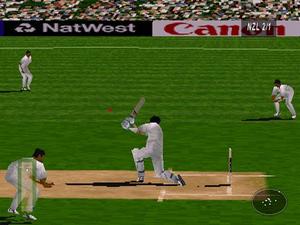
A gradual but inevitable descent into cricket-based loathing and bile.
In The Air! And Safe! And Out! #6: Shane Warne Cricket ’99 (Playstation)
Although we don’t particularly like to draw attention to it, it’s fair to say that, at times, we here at 51allout can be a little, well, impartial in our opinions. When it comes to talents like Saj Mahmood and Steve Smith, our parochial backing of them as the finest talents of their generation is entirely justified, but on the other hand James Franklin could take ten wickets and score a double hundred in a match and we’d still rubbish his performance. It’s what you come to expect from this quiet corner of the internet really.
So it won’t really surprise anyone that our prejudices spread beyond the game itself into other fields, and in particular the world of video games. This particular member of the team, at least, has no shame in admitting they are a blatant Nintendo fanboy. Not only have I owned every system Nintendo has put out, barring the Virtual Boy (fanboy? Yes. Idiot? Not quite), but as I sit here I am surrounded by all sorts of Nintendo themed paraphernalia, from Pokemon to some of the more esoteric characters Nintendo has created over the years. So it goes without saying that any system put out by one of Nintendo’s competitors, let alone the Evil Empire itself (otherwise known as Sony Entertainment), would get very short short shrift from my humble self. So obviously it would need a game of almost peerless brilliance to tempt me to put my prejudices momentarily aside. A game better than Gran Torino, or Metal Gear Solid. A game better, even, than Jumping Jack Flash. I speak, of course, of
#6: Shane Warne’s Cricket ’99
It’s hard to describe just why Shane Warne’s Cricket was so good. From first impressions it was very similar to most cricket games that came before it, in that bowling revolved around moving a cursor around on the pitch, and batting selecting from a limited number of shots, and whether to hit normally or ‘go the tonk’. The graphics were, for the time at least, pretty decent, although they barely hold up today. The animations were especially wonky. Every bowler looked like they had an action similar to Sohail Tanvir’s, and fielders ran around with all the enthusiasm of Saeed Ajmal. Yet the pitch looked the part, and aged nicely over the course of a Test match. But even better than that, and really one of the game’s trump cards, was the stadia. The game faithfully recreated nearly all the major cricket stadiums in the world. That, backed with the atmospheric sound, meant that Shane Warne’s Cricket was the first game that actually made it feel like you were playing on a dust bowl in India, or the subdued confines of Lord’s. It’s an achievement that in our opinion no game since has been able to match.
The game engine itself, whilst fairly basic, worked well. Perhaps the best part of the package was the fact that you could let the AI take over bowling and fielding duties completely. Since these are always the dullest part of any cricket game, this meant you could just concentrate on the fun bit, the batting. Sure, letting the game handle the bowling meant some pretty strange totals were generated, and sometimes you could find yourself chasing some mammoth totals, but that’s what you get for being lazy. And it just meant there was more of a challenge to chase them down. And as long as you set the game to the hardest difficulty, batting could often be quite a challenge indeed.
Shane Warne’s Cricket was one of the first games that introduced a confidence level with your batsmen, so that the more set they were the better they played. In recent games all this means is that you need to block a couple of balls before you start hooking half trackers for six behind square, but here it actually mattered. Short filth outside off actually represented a serious question for the player, in that did you try and cash in at the risk of feathering the ball into the slips, or instead let it go through to the ‘keeper? Since you had no on screen representation of how settled your batsman was, it was actually a serious dilemma, and batsmen who weren’t ‘in’ were more likely to edge than not. When you had a large total to chase down, throwing wickets away needlessly is obviously not a good idea, and in this respect the game rewarded batting patiently.
Since you could (and should) skip the bowling side of things altogether, you could actually set games to their proper length and still knock an ODI or Test match over in reasonable time. Which meant most of the time you were actually trying to bat responsibly, rather than just throwing the bat like in most cricket games. The game came with set scenarios that further took advantage of this. In the first such scenario you were put in Sri Lanka’s shoes in the 1996 World Cup final, set the task of chasing down 241 after being reduced to 23/2. It was no easy task, and the need to build the innings over the 50 overs showed the player that this wasn’t a game that was going to pull its punches.
That really was the secret to Shane Warne Cricket’s success; it didn’t treat the player like an idiot. To win you actually had to play sensibly, and that meant that sometimes trying to grind out a draw on a wearing fifth day pitch was your best option. Most cricket games would never attempt to force the player into such a scenario, probably because they are created with mass consumption in mind and casual players would seemingly be put off by it. Shane Warne’s didn’t give a crap about that, and it was the better game for it.
The unforgiving nature of the game itself, along with the effort put in by Codemasters off the pitch (we haven’t even mentioned how you could play a career mode where the game kept track of every player’s statistics) really puts a lot of more modern versions to shame, where a barely functional game engine is given only the most basic window dressing before being shoved out the door. It’s a shame that over a decade after its release Shane Warne’s Cricket still stands as the high point of the genre.



2 Comments
Post a Comment
1
Brian Wilkinson
02 Jun 2013 14:07
This game was an absolute belter, having played it in it’s BLC format. The pitches genuinely were varied, damp minefields to dustbowls and the commentary – mostly Aggers “That’s a sloppy piece of cricket” and Boycs “That was so short it was a long hop. My mum could have hit that” brought an air of realism.
The only criticism was that the game could be a bit easy, especially with bowling. Even with the filthiest of spinners – Croft and Tuffers an Attacking 3 field with slip, leg slip, and mirrored silly mids would regularly result in collapses. Pakistan all out for 9 in Test level springs to mind. If you used the triangle button to vary height, the batsman as would nearly always tamely pop a catch to silly mid on or leg gully sweeping, or be given out LBW to a ball that pitched well outside leg stump. Sadly there was no DRS in those days to save the Batsman. Just like in India. Nonetheless the best bit of bowling with this approach was that when the batsman defended the ball, silly mid on would dive over it, and slip would run round and retrieve it. I would only advocate this approach for Cosgrove.
Fast bowling was fun, with accuracy and pressure building rewarded. oh, and first ball of the match you could knock over the stumps while the batsman was taking his guard. Immoral, but utterly acceptable. Especially against the Aussies. Oh and you could bowl slower ball bouncers. Unlike dearest Saj however, you occasionally got someone out.
See, your approach to batting is commendable. Watchful, patient. However the easiest way to score massively was just to use the circle button for anything wide, and smash it into the stands. Which it would do nearly every time. Using this approach, Adam Hollioake, (yes the fella who was deceived by Warnie’s straight one) made a 27 ball hundred. Whilst I’d like to believe I was truly brilliant, envy thing else points to it being a bit easy.
This all went out off the window on a sticky wicket, the top order in the hutch for not many – There was only one batsman for that, good old beaky Nass. There was the the drop and run, square then X. This worked all very well, until Nass got run out. True to form. 2 short of a hundred. I fear for the fridge. And obviously Aggers was there, gloating: “That was a suicidal run out”. Thanks Aggers.
Probably the best feature of this game though was the ability to track averages, and plays seasons and series of test cricket. If only the unlikely lads could get some of those a figures – an example – Crofts BBI 5-5-0-5. Maybe letting the computer do the bowling was the better option all along!
Still the best cricket game I’ve ever played.
2
Stuart Johnson
12 Oct 2012 13:20
Brian Lara Cricket (as my version was called) was the reason that I got into cricket in the first place. I like cricket as a child but lost interest in my teenage years. But come my early 20s I picked this game up and suddenly I was drawn into the subtleties of cricket and just haven’t look back since. Coinciding more or less with the start of Channel 4’s coverage of cricket in the UK, it was a great time for anyone learning about cricket!
No cricket game has come anywhere near to recreating Brian Lara Cricket since